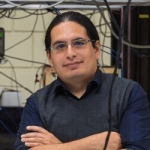Quantum News Briefs August 18: SandboxAQ developing quantum navigation system for USAF to complement GPS; SpeQtral-1 will serve as a pathfinder commercial demonstrator for future quantum key distribution services; Sandia & Duke University collaborate on new ion trap to boost quantum algorithms research + MORE

Quantum News Briefs August 18:
SandboxAQ developing quantum navigation system for USAF to complement GPS
 SandboxAQ is developing a quantum navigation system for the US Air Force (USAF) to complement the Global Positioning System (GPS). Quantum News Briefs summarizes August 17 article by Inder Singh Bisht in DefensePost.
SandboxAQ is developing a quantum navigation system for the US Air Force (USAF) to complement the Global Positioning System (GPS). Quantum News Briefs summarizes August 17 article by Inder Singh Bisht in DefensePost.
The USAF-funded system is being designed to assist GPS in degraded, contested, or denied environments where the system could lose precision.
The US-based GPS faces challenges such as weak signals due to obstacles, excessive noise, poor signal-to-noise ratio, and jamming and spoofing by adversaries.
The system being developed by SandboxAQ uses the Earth’s magnetic field as a signal similar to how birds navigate specific migratory patterns.
The system fuses quantum sensors to measure the magnetic field and AI to filter out noise and improve signal processing. Click here to read article in-entirety.
SpeQtral-1 will serve as a pathfinder commercial demonstrator for future quantum key distribution services
 SpeQtral, a leading quantum communication technology company, has chosen Kongsberg NanoAvionics (NanoAvionics) as the satellite bus provider for its upcoming SpeQtral-1 mission. Quantum News Briefs summarizes August 16 announcement in Space Commerce.
SpeQtral, a leading quantum communication technology company, has chosen Kongsberg NanoAvionics (NanoAvionics) as the satellite bus provider for its upcoming SpeQtral-1 mission. Quantum News Briefs summarizes August 16 announcement in Space Commerce.
Using the technical expertise of NanoAvionics as a leading smallsat bus manufacturer and mission integrator, and Mbryonics’s state-of-the-art optical terminal hardware, SpeQtral-1 will serve as a pathfinder commercial demonstrator, defining future quantum key distribution (QKD) services. The second partner in this mission is Mbryonics, producing the satellite’s optical terminal.
SpeQtral-1 is aimed at providing communications services that require quantum security, as traditional cryptographic techniques are threatened by the emergence of quantum computing. The nanosatellite is based on NanoAvionics’s high-performance and multi-purpose M16P bus, which has been flight proven during multiple Earth observation missions. The satellite’s quantum-optical terminal by Mbryonics will transmit QKD photons from the satellite’s hardware down to optical ground stations.
The mission is also slated to be used alongside SpeQtre (expected to launch this year) as the space segment for the ESA INT-UQKD programme, which will explore international use cases for operational QKD applications and services.
SpeQtral-1 will be SpeQtral’s second QKD satellite, following the SpeQtre technology demonstrator mission, itself built on technologies demonstrated on the 2019 SpooQy-1 CubeSat. Click here to read the complete announcement.
Sandia & Duke University collaborate on new ion trap to boost quantum algorithms research


Sandia National Laboratories has produced its first lot of a new world-class ion trap, a central component for certain quantum computers. The new device, dubbed the Enchilada Trap, enables scientists to build more powerful machines to advance the experimental but potentially revolutionary field of quantum computing.
In addition to traps operated at Sandia, several traps will be used at Duke University for performing quantum algorithms. Duke and Sandia are research partners through the Quantum Systems Accelerator, one of five U.S. National Quantum Information Science Research Centers funded by the Department of Energy’s Office of Science.
With sufficient control hardware, the Enchilada Trap could store and transport up to 200 qubits using a network of five trapping zones inspired by its predecessor, the Roadrunner Trap. Both versions are produced at Sandia’s Microsystems Engineering, Science and Applications.
Sandia has researched, built and tested ion traps for 20 years. To overcome a series of design challenges, the team combined institutional knowledge with new innovations.
Sandia had experimented with similar junctions in previous traps. The Enchilada Trap uses the same design in a tiled way so it can explore scaling properties of a smaller trap. Stick believes the branching architecture is currently the best solution for rearranging trapped ion qubits and anticipates that future, even larger versions of the trap will feature a similar design.
“Our team is always looking ahead,” said Sandia’s Zach Meinelt, the lead integrator on the project. “We collaborate with scientists and engineers to learn about the kind of technology, features and performance improvements they will need in the coming years. We then design and fabricate traps to meet those requirements and constantly seek ways to further improve.” Click here to read announcement in-entirety.
The impact of European quantum sensors on global connectivity
 The impact of European quantum sensors on global connectivity is multifaceted. Quantum News Briefs summarizes an August 10 Fagen Wasanni Technologies article.
The impact of European quantum sensors on global connectivity is multifaceted. Quantum News Briefs summarizes an August 10 Fagen Wasanni Technologies article.
In the telecommunications sector, these sensors are expected to enhance the speed, capacity, and reliability of data transmission. They can detect and correct errors in real-time, thereby reducing latency and improving the quality of service. This could revolutionize the way we communicate, making it possible to transmit large volumes of data across vast distances with minimal loss of information.
In the field of navigation, quantum sensors could provide a viable alternative to Global Positioning System (GPS) technology. They can measure gravitational fields with such precision that they can determine a location based on the Earth’s gravitational anomalies. This could lead to the development of a new generation of navigation systems that are immune to interference and can function even in the most challenging environments.
In the security sector, quantum sensors could enhance the detection of threats and the protection of critical infrastructure. They could be used to detect hidden explosives, monitor border crossings, or even identify cyber threats by detecting anomalies in data traffic.
The potential of European quantum sensors is immense, but their successful deployment hinges on overcoming several challenges. These include the need for robust quantum algorithms, the development of scalable manufacturing processes, and the establishment of regulatory frameworks that safeguard privacy and security while fostering innovation.
In conclusion, European quantum sensors are set to play a pivotal role in shaping the future of global connectivity. They promise to deliver unprecedented levels of precision, reliability, and versatility, thereby transforming the way we communicate, navigate, monitor health, and ensure security. Click here to read the original article in-entirety.
Sandra K. Helsel, Ph.D. has been researching and reporting on frontier technologies since 1990. She has her Ph.D. from the University of Arizona.





















